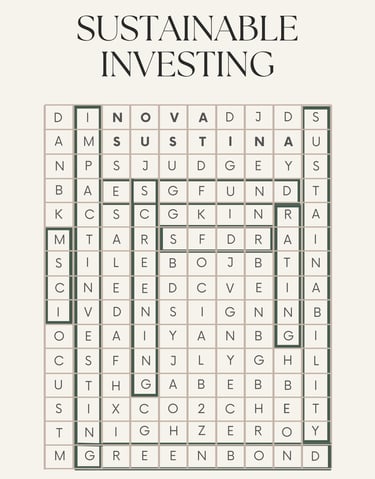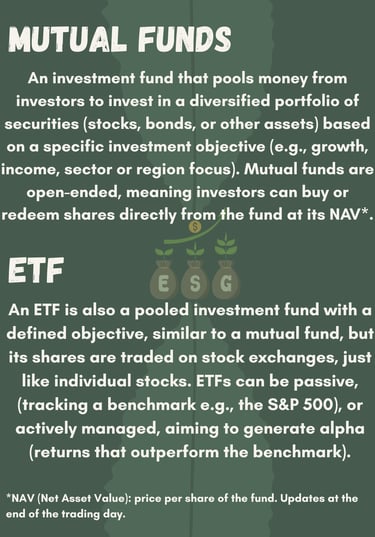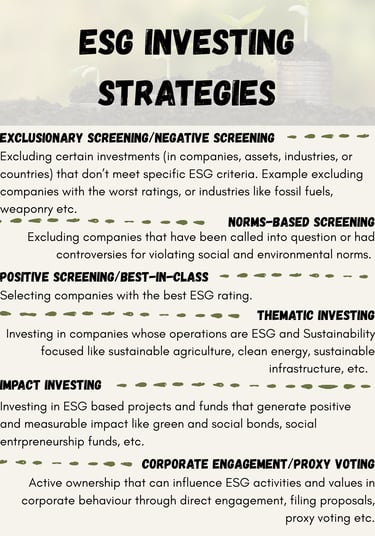Sustainable Finance Products
Investing in the ESG space is an area that could use some spotlight. As an investor looking to build a sustainable portfolio it can be difficult to diversify your funds in a way that can safeguard your hard-earned money. According to Morgan Stanley's 'Sustainability Reality' report, sustainable funds outperformed traditional funds in the first half of 2025. This report aims to help investors and ESG enthusiasts look into the various types of ESG investing and how you can identify where to invest. Before you begin, we suggest going through the various terminology related to sustainable finance provided in the link below.


Note: Information on Green bonds, social bonds and alternative ESG investments will be published by 22nd November 2025.
ESG Mutual Funds
Identifying green investment funds
1) Fund Name: The fund name is the first indication of the focus of the fund. They're long enough to give you a hint of where to look into, however, it's not the main indication because of the discretionary manner in which investments are made. Examples of fund names include: Berenberg Sustainable World Equities, Nordea 1 – Global Climate and Environment Fund, Bloomberg MSCI Euro Corporate ESG Sustainability SRI, and so on.
2) EU SFDR: Under the SFDR, funds that integrate sustainability in their portfolios involve the investment in companies that are in the business of, or integrate, environmental solutions, have good governance and social practices, as well as social due diligence. SFDR has two main classifications for ESG related funds and these are Article 8 (light green) and Article 9 (dark green). Article 8 integrates ESG in investment decisions but puts financial performance ahead of sustainability, and is not as stringent as Article 9 which involves sustainability objectives as the primary investment objective. It is oriented towards impact investing. Article 9 has three requirements: have positive impact (environmental and social), do no harm, and have strong governance.
3) Labels: Labels in the corporate world include those of B-Corp, Ecovadis, ISO, and several others. For product-related labels there are labels from Rainforest Alliance, Fairtrade, etc. Similarly there are several firms in EU that provide labels for investment funds based on a pass-or-fail system or using a point system, both of which require a minimum threshold to be qualified for a label for ESG investing. These organisations can be formed in tandem with Government institutions, Stock Exchanges, Industry Associations or non-profits. Some labels are issued after review from an external reputable third-party auditor. Here's a list of organisations that provide eco-labels:
FNG-Siegel: https://fng-siegel.org
Label ISR: https://www.lelabelisr.fr
LuxFLAG ESG: https://luxflag.org/labels/esg/
Nordic Swan: https://www.nordic-swan-ecolabel.org/criteria/investment-funds-and-investment-products-101/
Towards Sustainability: https://towardssustainability.be
Umweltzeichern Ecolabel: https://www.umweltzeichen.at/de/produkte/finanzprodukte
4) Rating: Ratings are an aspect where an investor needs to be proactive with knowing what the rating means because different rating agencies provide different scores based on different criteria and methodology. It's not a uniform standard and is not easily comparable between different rating agencies. The following is a list of Rating agencies:
Morningstar Sustainalytics: https://www.sustainalytics.com/investor-solutions/analytic-reporting-solutions/morningstar-esg-risk-rating-for-funds#morningstar
MSCI ESG Ratings: https://www.msci.com/data-and-analytics/sustainability-solutions/esg-ratings
ISS ESG Fund Rating: https://www.issgovernance.com/sustainability/fund-rating/
5) Investor Documents: Funds will have a prospectus, key investor information document, sustainability report, fund investment log, and published historical performance. These documents give insights into investment objective which could be based on an ESG investment strategy, selection and portfolio construction, type of investments excluded from the fund e.g. fossil fuels industry, detailed investment screening and ESG metrics evaluated, and the benchmark fund it is measured against.




Green Bonds and Social Bonds
Disclosure
This website does not send email alerts, newsletters, or unsolicited subscription requests. All contact is initiated through the contact form, which enables direct communication via personal email for those who wish to engage further.
All users are encouraged to read our Terms and Conditions
